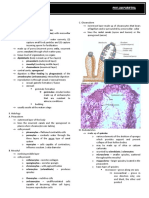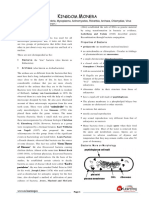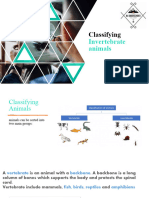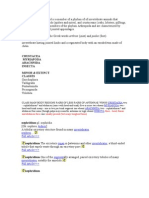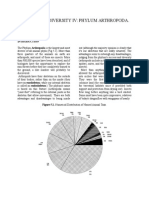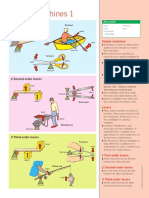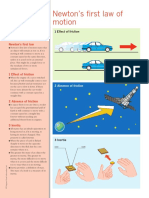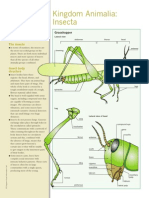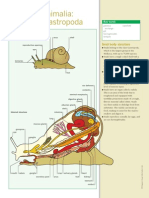Professional Documents
Culture Documents
SVRbio118-Chilopoda and Diplopoda
Uploaded by
anoeta0 ratings0% found this document useful (0 votes)
634 views1 pageChilopoda and Diplopoda
Copyright
© © All Rights Reserved
Available Formats
PDF, TXT or read online from Scribd
Share this document
Did you find this document useful?
Is this content inappropriate?
Report this DocumentChilopoda and Diplopoda
Copyright:
© All Rights Reserved
Available Formats
Download as PDF, TXT or read online from Scribd
0 ratings0% found this document useful (0 votes)
634 views1 pageSVRbio118-Chilopoda and Diplopoda
Uploaded by
anoetaChilopoda and Diplopoda
Copyright:
© All Rights Reserved
Available Formats
Download as PDF, TXT or read online from Scribd
You are on page 1of 1
Kingdom Animalia:
Chilopoda and Diplopoda
Chilopoda (centipede)
Dorsal view
Diplopoda (millipede)
External view
antenna
eyes
legs (jointed)
diplosegment
antenna
maxilliped
(poison claw)
legs
(jointed)
tergal plate
telson
Chilopoda (Scutigera)
Lateral view of head
first maxilla
second maxilla
maxilliped (poison claw)
eyes
first tergal plate
first leg second tergal plate
second leg
The Chilopoda
The Chilopoda are commonly known
as centipedes. There are roughly 3,000
species of centipedes, ranging from
about 1 inch (3 cm) in length to 10
inches (26 cm) for some tropical
species.
Centipedes have a single pair of legs
on each segment, with the front-most
ones being modified into claws
equipped with poison glands. These
front legs are called maxillipeds and
allow the centipedes to be effective
predators.
Eyes are simple rather than
compound.
The upper and lower surfaces of the
trunk segments are armored with
thickened plates called tergal plates
and are joined by a flexible membrane.
The last division of the body, the
telson, is not considered a true
segment because it lacks legs.
Centipedes live mainly in soil and
humus and under stones and rocks.
The Diplopoda
The Diplopoda, commonly known as
millipedes, have two pairs of legs on
each body segment. The average
millipede species (of which there are
10,000) will have between 100 and 300
legs in total, although the Illacme
plenipes species has 750 legs.
Millipede length ranges from 0.08 to
12 inches (2300 mm) with most
species between 2 and 6 inches
(50150 mm).
Most millipedes are detritivores or
herbivores. They eat decaying organic
matter and plants.
Eyes tend to be simple.
Milipedes are nocturnal and avoid
becoming prey to the more aggressive
centipedes by producing an irritating
substance from glands in the thorax.
This substance is released when they
feel threatened.
herbivore
maxilliped
predator
segment
Key words
D
i
a
g
r
a
m
V
i
s
u
a
l
I
n
f
o
r
m
a
t
i
o
n
L
t
d
.
You might also like
- Kelompok 3-SIstem PencernaanDocument103 pagesKelompok 3-SIstem PencernaanNurul Fadhillah IsaNo ratings yet
- 2nd Exam ReviewerDocument11 pages2nd Exam Reviewerdmt01081991No ratings yet
- Glaucophyta 1Document17 pagesGlaucophyta 1Carla MaldonadoNo ratings yet
- Order ScandentiaDocument34 pagesOrder ScandentiaUlinBlabliblublebloNo ratings yet
- I. Polypodiopsida (Licopsida) : A. Order: OsmundalesDocument26 pagesI. Polypodiopsida (Licopsida) : A. Order: OsmundalesCDB 1st Semester 2077No ratings yet
- Kingdom MoneraDocument29 pagesKingdom MoneraAashishNo ratings yet
- CycadophytaDocument4 pagesCycadophytaYobain MoralesNo ratings yet
- Xanthophyta and PhaeophytaDocument18 pagesXanthophyta and PhaeophytaPablo VeraNo ratings yet
- Chlorophyta VolvoxDocument6 pagesChlorophyta VolvoxArista Novi Hana PratiwiNo ratings yet
- Desarrollo Embrionario - Pez Monja - Gymnocorymbus TernetziDocument16 pagesDesarrollo Embrionario - Pez Monja - Gymnocorymbus TernetziYuaika NekoNo ratings yet
- From Wikipedia, The Free Encyclopedia Jump To: ,: LeucosoleniaDocument62 pagesFrom Wikipedia, The Free Encyclopedia Jump To: ,: LeucosoleniaSuci AgustianiNo ratings yet
- CHONDRICHTHYESDocument61 pagesCHONDRICHTHYESFitriyani 2012No ratings yet
- Mollusca and ArthropodaDocument7 pagesMollusca and ArthropodaRegina LegaspiNo ratings yet
- Laporan Praktikum Aktivtas Dan Jarak Edar Bekicot Kelompok 3 ICPDocument25 pagesLaporan Praktikum Aktivtas Dan Jarak Edar Bekicot Kelompok 3 ICPNurul Fitrah 2008No ratings yet
- Notes On The Phylum PORIFERADocument20 pagesNotes On The Phylum PORIFERAnoblefx100% (1)
- Daftar Pustaka PDFDocument7 pagesDaftar Pustaka PDFaulia rahmiNo ratings yet
- Portofolio EvolusiDocument100 pagesPortofolio EvolusiNabila MahgfiraNo ratings yet
- Canal System in PoriferaDocument6 pagesCanal System in Poriferasakibsharief911No ratings yet
- CentipedesDocument2 pagesCentipedesPei LingNo ratings yet
- Introductory Entomology: Third Semester Lamjung CampusDocument206 pagesIntroductory Entomology: Third Semester Lamjung Campusnishan khatriNo ratings yet
- Trilobites Chelicerates and MyriapodsDocument61 pagesTrilobites Chelicerates and MyriapodsKyrby CabalquintoNo ratings yet
- Arthropoda: (Type The Author Name)Document12 pagesArthropoda: (Type The Author Name)Mudzakir TaufiqNo ratings yet
- Classification of InvertebratesDocument1 pageClassification of InvertebratesJaycel Maeh T. MangmangNo ratings yet
- 1.4 InvertebrateDocument14 pages1.4 Invertebratebekzatalpbekov2008No ratings yet
- Arthropoda Lecture - 2023Document13 pagesArthropoda Lecture - 2023BHEKUMUSA MASEKONo ratings yet
- Arthropod Written DocumentDocument7 pagesArthropod Written DocumentAngelo Recomo100% (1)
- Esquema Visu Con FotosDocument25 pagesEsquema Visu Con FotosraquelgergalNo ratings yet
- Practical 4Document7 pagesPractical 4Nick YuNo ratings yet
- Linnean - Nomenclature - Week - One - Docx Filename - UTF-8''Linnean Nomenclature Week OneDocument32 pagesLinnean - Nomenclature - Week - One - Docx Filename - UTF-8''Linnean Nomenclature Week OneKaydina GirNo ratings yet
- Lab 5 - ArthropodsDocument12 pagesLab 5 - ArthropodsObi GoodnessNo ratings yet
- Invertebrates AntonetteDocument27 pagesInvertebrates Antonetteduganirene1No ratings yet
- Report of Analysis Animal Comparison Analysis Between: Grasshopper and DamselfliesDocument10 pagesReport of Analysis Animal Comparison Analysis Between: Grasshopper and DamselfliesReynanda ApriliaNo ratings yet
- ArthropodsDocument544 pagesArthropodsAnjum Ansh KhanNo ratings yet
- Arthropod PDFDocument16 pagesArthropod PDFmanricoNo ratings yet
- DefinitionDocument2 pagesDefinitionkughaprianNo ratings yet
- Introduction Lab 4Document4 pagesIntroduction Lab 4Alan SurumbutNo ratings yet
- 08 Phylum NematodaDocument6 pages08 Phylum NematodaJeremy NocedaNo ratings yet
- Ph. Arthropoda: Subphylum Myriapoda: (Centipedes, Millipedes, and Their Kin)Document51 pagesPh. Arthropoda: Subphylum Myriapoda: (Centipedes, Millipedes, and Their Kin)PabloDarlanNo ratings yet
- Invertebrate Lab 7Document12 pagesInvertebrate Lab 7Shaker MahmoodNo ratings yet
- 016 Fanged + Venomous SnakesDocument563 pages016 Fanged + Venomous SnakesCharlette JauchNo ratings yet
- Kingdom Animalia: ClassificationDocument1 pageKingdom Animalia: ClassificationanoetaNo ratings yet
- ArthropodsDocument41 pagesArthropodsJolina HerreraNo ratings yet
- المحاضرة 2Document7 pagesالمحاضرة 2Salah Abd El-MageedNo ratings yet
- Turtles Tuataras Lizards Snakes Crocodiles Tetrapods: ReptilesDocument1 pageTurtles Tuataras Lizards Snakes Crocodiles Tetrapods: ReptilesAji Nikka AngelesNo ratings yet
- Animalia 2Document63 pagesAnimalia 2Rida IshanurNo ratings yet
- Sponges: Anthozoa Hydrozoa ScyphozoaDocument3 pagesSponges: Anthozoa Hydrozoa ScyphozoaPaul Michael P. GarciaNo ratings yet
- Lab 8 Arthro PDFDocument9 pagesLab 8 Arthro PDFAtin FifaNo ratings yet
- Classification of InsectDocument7 pagesClassification of InsectRowie WanawanNo ratings yet
- Lab ArtropodeDocument15 pagesLab ArtropodeVonna IonescuNo ratings yet
- Phylum ArthropodaDocument178 pagesPhylum ArthropodaLibardo CaraballoNo ratings yet
- Animal EarthDocument20 pagesAnimal EarthRoss Piper67% (3)
- Centipede: Question: What Goes 99 Clunk? Answer: A Centipede With A Wooden LegDocument2 pagesCentipede: Question: What Goes 99 Clunk? Answer: A Centipede With A Wooden LegangeunkacangNo ratings yet
- InvertebratesDocument32 pagesInvertebratesKenneth AldeguerNo ratings yet
- Sishe Salsabila Luqyana Practicum ReportDocument27 pagesSishe Salsabila Luqyana Practicum ReportSalsabila LuqyanaNo ratings yet
- Planeta Fauna: Life of Reptiles: Abainza, Dimaculangan, Maglaque, Matibag, Medina, Rigodon, Tamayo, Tan Compana A51Document90 pagesPlaneta Fauna: Life of Reptiles: Abainza, Dimaculangan, Maglaque, Matibag, Medina, Rigodon, Tamayo, Tan Compana A51Justin MatibagNo ratings yet
- Students UG PPT 1Document70 pagesStudents UG PPT 1amanu kassahunNo ratings yet
- Phylum ArthropodaDocument4 pagesPhylum ArthropodaYogesh PrajapatiNo ratings yet
- Simple Machines 2: 1 Pulley SystemsDocument1 pageSimple Machines 2: 1 Pulley SystemsanoetaNo ratings yet
- SVRphy16 PDFDocument1 pageSVRphy16 PDFanoetaNo ratings yet
- SVRphy17 PDFDocument1 pageSVRphy17 PDFanoetaNo ratings yet
- SVRphy19 PDFDocument1 pageSVRphy19 PDFanoetaNo ratings yet
- SVRphy18 PDFDocument1 pageSVRphy18 PDFanoetaNo ratings yet
- SVRphy15 PDFDocument1 pageSVRphy15 PDFanoetaNo ratings yet
- SVRphy14 PDFDocument1 pageSVRphy14 PDFanoetaNo ratings yet
- SVRphy8 PDFDocument1 pageSVRphy8 PDFanoetaNo ratings yet
- SVRphy12 PDFDocument1 pageSVRphy12 PDFanoetaNo ratings yet
- SVRphy13 PDFDocument1 pageSVRphy13 PDFanoetaNo ratings yet
- SVRphy10 PDFDocument1 pageSVRphy10 PDFanoetaNo ratings yet
- SVRphy9 PDFDocument1 pageSVRphy9 PDFanoetaNo ratings yet
- SVRphy11 PDFDocument1 pageSVRphy11 PDFanoetaNo ratings yet
- Free Fall and Terminal Velocity: 1 Gravity: Action at A DistanceDocument1 pageFree Fall and Terminal Velocity: 1 Gravity: Action at A DistanceanoetaNo ratings yet
- Archimedes' Pump: Martin Gardner, Hendersonville, NC 28792Document1 pageArchimedes' Pump: Martin Gardner, Hendersonville, NC 28792anoetaNo ratings yet
- Kingdom Animalia: Insecta: The InsectsDocument1 pageKingdom Animalia: Insecta: The InsectsanoetaNo ratings yet
- CHIJKatong Convent 2011Document7 pagesCHIJKatong Convent 2011anoetaNo ratings yet
- SVRbio114 - MolluscaDocument1 pageSVRbio114 - MolluscaanoetaNo ratings yet
- Newton's First Law of MotionDocument1 pageNewton's First Law of MotionanoetaNo ratings yet
- SVRbio115 - GastropodaDocument1 pageSVRbio115 - GastropodaanoetaNo ratings yet
- SVRbio112 - Nematoda Life CycleDocument1 pageSVRbio112 - Nematoda Life CycleanoetaNo ratings yet
- SVRbio126 MammaliaDocument1 pageSVRbio126 MammaliaanoetaNo ratings yet
- Kingdom Animalia: ClassificationDocument1 pageKingdom Animalia: ClassificationanoetaNo ratings yet
- SVRbio120 EchinodermataDocument1 pageSVRbio120 EchinodermataanoetaNo ratings yet
- SVRbio117 - CrustaceaDocument1 pageSVRbio117 - CrustaceaanoetaNo ratings yet
- SVRbio107 - CnidariaDocument1 pageSVRbio107 - CnidariaanoetaNo ratings yet
- SVRbio125 AvesDocument1 pageSVRbio125 AvesanoetaNo ratings yet
- SVRbio118-Chilopoda and DiplopodaDocument1 pageSVRbio118-Chilopoda and DiplopodaanoetaNo ratings yet
- Kingdom Animalia: Chondrichthyes: DogfishDocument1 pageKingdom Animalia: Chondrichthyes: DogfishanoetaNo ratings yet
- Kingdom Animalia: ClassificationDocument1 pageKingdom Animalia: ClassificationanoetaNo ratings yet

